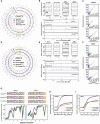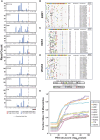3'-end ligation sequencing is a sensitive method to detect DNA nicks at potential sites of off-target activity induced by prime editors
- PMID: 40764055
- PMCID: PMC12401060
- DOI: 10.1101/gr.280164.124
3'-end ligation sequencing is a sensitive method to detect DNA nicks at potential sites of off-target activity induced by prime editors
Abstract
Gene editing makes precise changes in DNA to restore normal function or expression of genes; however, the advancement of gene editing to the clinic is limited by the potential genotoxicity of off-target editing. To comprehensively identify potential sites in the genome that may be recognized by gene editing agents, in vitro approaches, in which the editor is combined with human genomic DNA and sites where editing may occur are identified biochemically, are important tools. Existing biochemical approaches for off-target discovery recognize double-stranded breaks generated by nuclease-based gene editors such as SpCas9, but novel approaches are needed for new editing modalities, such as prime editing, that nick one strand of DNA. To fill this gap, we have developed 3'-end ligation sequencing (PEG-seq), which can identify prime editor-induced nicks throughout the genome on in vitro digested human genomic DNA to identify potential off-target sites. Here we show that PEG-seq is an important addition to the off-target detection toolkit, enabling off-target discovery for DNA nicking gene editors such as prime editors.
© 2025 Stewart-Ornstein et al.; Published by Cold Spring Harbor Laboratory Press.
Figures





References
MeSH terms
Substances
LinkOut - more resources
Full Text Sources
Miscellaneous
